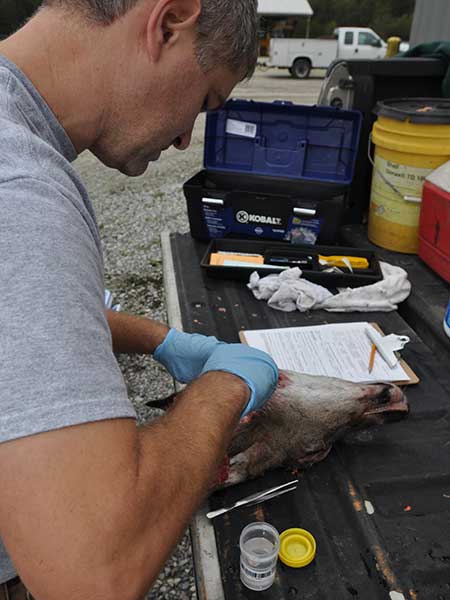
Scott McLean samples a Pender County deer for Chronic Wasting Disease in October 2013, the last round of CWD testing paid for by hunters through license fees.
The most likely method of the disease entering the state is through an illegal importation of a deer or elk that has not come from a herd certified as disease-free. Are deer wild animals or livestock? Will let your current legislators decide for you?
An article in Great Lakes Echo (http://greatlakesecho.org) shows how far deer farmers will go to earn a buck. It sheds light on why deer hunters must become involved in the legislative process to prevent risking importation of deer with Chronic Wasting Disease.
A lucky traffic stop discovered an illegal shipment of deer heading to Georgia from Ohio that led to 12 charges against a former co-owner of shooting preserves in Ohio and Florida. Donald Wainwright Sr. pleaded guilty to 12 charges and received a 21-month prison sentence and $125,000 fine. Charges against his son, Donald Wainwright Jr. are pending in a plea deal that involves seven others including Ben Chason, partner in Valley View Whitetails and owner of Cherokee Whitetails.
CWD was first found in captive mule deer in Colorado in 1967 and first found in the wild in Colorado elk in 1981. It spread in lockstep with a burgeoning deer farming industry that transported deer primarily so shooters could kill heavy-antlered bucks for high fees. Onerously, CWD-infected wild deer were identified in Virginia in 2010, Iowa in 2014 and Michigan in 2015. So far, biologists have found no CWD-infected deer in North Carolina where hunting deer inside fences is illegal - except on the Cherokee Reservation.
Deer farmers have gone to great lengths to keep their activity alive, despite CWD having spread to 23 states. They must keep finding CWD-free states like North Carolina to ensure continued operations. Their efforts to lift North Carolina's ban on new deer farm permits was successful, resulting in the NCWRC issuing permits for two new deer farms for a total of 36.
Despite receiving more permits, deer farmers felt NCWRC's regulations are still too restrictive and had legislation introduced that would move joint oversight of deer farms by NCWRC and N.C. Department of Agriculture to the NCDA, a tactic used in other states. A similar bill passed the West Virginia House in February. Section 14 of Senate Bill 513 passed the N.C. Senate on May 19 and recently passed the House Agriculture Committee. It is now in the Finance Committee, where if it passes, it will come to a vote. If it passes the House vote, variations will be ironed out with the Senate version before it heads to the Governor.
Central to deer farmers' argument for taking regulatory authority away from NCWRC is that deer and elk are livestock, not wildlife. Judy Gardner, a deer farming and CWD consultant to the N.C. Wildlife Federation, Quality Deer Management Association and N.C. Camouflage Coalition, disagrees.
"It is a national campaign," Gardner said. "Deer farmers are trying to get deer and elk labeled as livestock. If two-thirds of states change the classification of wild deer and elk to livestock, they can have the Lacey Act amended to exclude them as captive cervids so they will not be subject to the Act's laws and penalties for illegally transporting wildlife across state lines. If regulation of wild deer and elk goes under USDA, there will also be limited access to the public for determining where an introduction of disease may have occurred."
CWD is 100 percent fatal to deer but, so far, has not infected humans. Caused by a folded protein called a prion, it causes sponge-like brain deterioration similar to Mad Cow Disease. It spreads animal to animal or by feeding activity among cervids, but ongoing studies show CWD infects other animals under controlled conditions. Once the prions enter soil they remain infectious for an undetermined time.
Containment measures include killing massive numbers of deer over large areas to prevent CWD spread, but nowhere have they been effective. If the disease enters North Carolina, deer hunting will no longer exist as hunters have known it. Based on other states' experiences, many or most hunters stop hunting deer rather than risking contact with an infected animal.
Even with strict regulations in place to stop CWD's spread, money made by raising and shooting large-antlered deer inside pens is too great and penalties too lenient to prevent some deer farmers from risking illegal transportation. According to Great Lakes Echo, Wainright's lawyer argued for dismissal, saying the Lacey Act doesn't apply because deer bred and raised in pens are not wildlife. U.S. District Judge Edmund Sargus Jr. rejected that argument, saying white-tailed deer are wild and courts should inquire whether a species - not an individual specimen - is wild because the law prevents animals normally found in a state of wildness from losing their wildness.
North Carolina hunters already bear the cost of CWD by paying through license fees for NCWRC to perform statewide testing. Deer farmers make a few million dollars, but white-tailed deer hunting is a $1 billion industry in N.C. Do citizens of North Carolina who love white-tailed deer for the true, intrinsic value that is their very wildness want them managed as livestock or as wildlife?
Passage of Section 14 of Senate Bill 513 will make that distinction for them if they allow it to happen. If CWD arrives at a farm with an uncertified deer, it won't matter anymore. Captive or wild, deer and deer hunting in this state will begin to die.
To read the bill, visit http://www.ncleg.net/Sessions/2015/Bills/Senate/PDF/S513v5.pdf.
